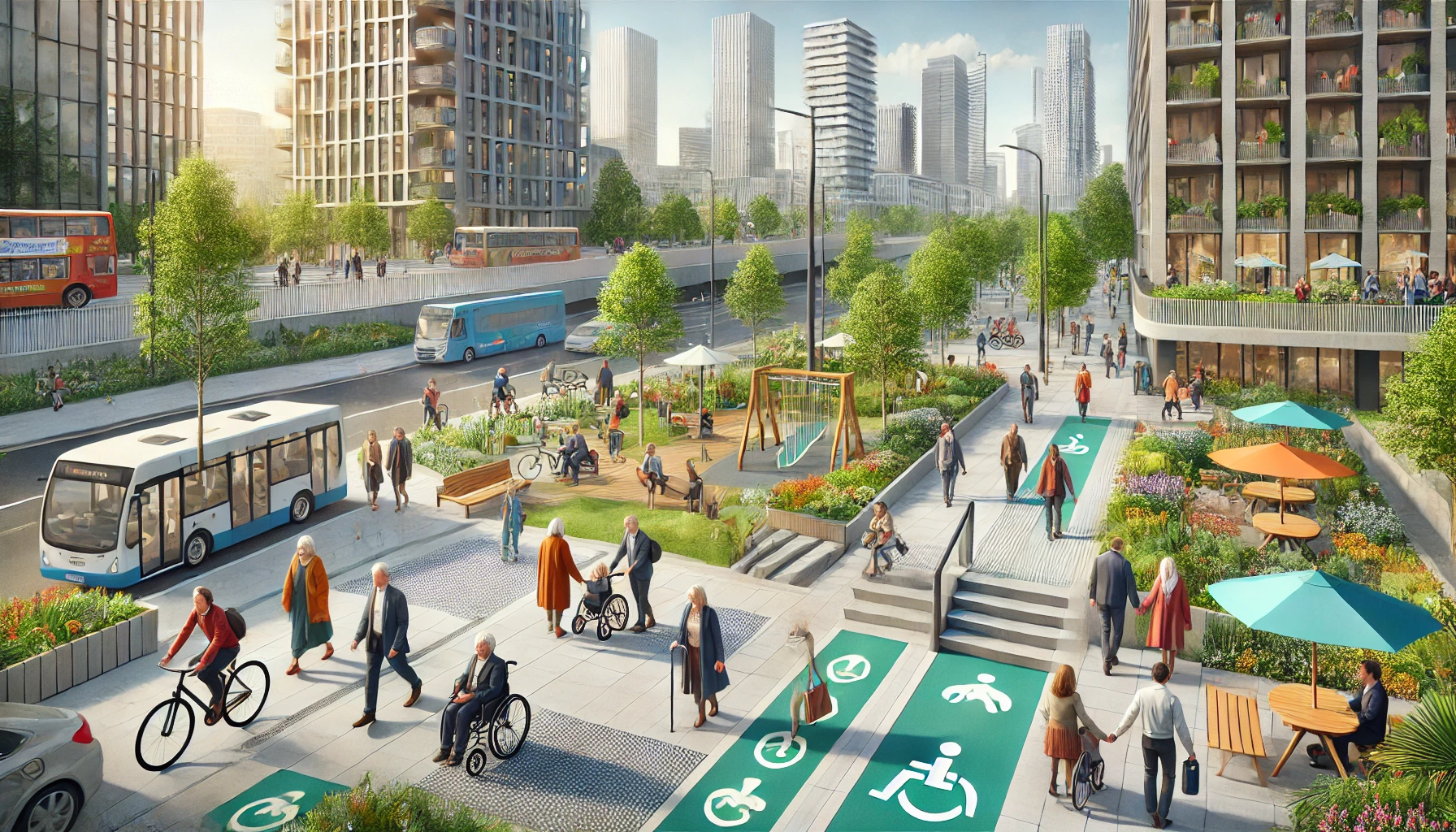As urban areas continue to expand, the importance of inclusive urban design grows. This design approach ensures that city spaces are open, safe, and inviting for all, no matter the age, gender, ability, or social status. It aims to foster social fairness, remove obstacles, and nurture lively communities. This article delves into the principles, advantages, and practices of inclusive urban design, showcasing how cities globally are evolving to create fairer urban environments.
What is Inclusive Urban Design?
Inclusive urban design strives to craft spaces that respect and embrace the diversity of all users. Unlike traditional urban planning, which might favor cars or assume a standard user profile, inclusive design takes into account the varied needs of different groups. This could involve making spaces accessible for people with disabilities, designing for young and older people, and creating safe, welcoming areas for women, LGBTQ+ individuals, and minority communities.
Core Principles of Inclusive Urban Design
To build a truly inclusive urban space, several key principles are essential:
- Accessibility: Ensure that public areas, transport options, and facilities are available to everyone, including those with disabilities. Features like ramps, tactile paving, braille signs, and audible signals at crosswalks are some ways to enhance accessibility.
- Equity: Distribute resources and services fairly across all neighborhoods, including those that are underprivileged or marginalized. Equity in design addresses the different needs of various communities, aiming to provide equal chances for everyone to use and enjoy public spaces.
- Safety and Comfort: Design spaces that are safe and comfortable for all users. This involves good lighting, visibility, and creating community-friendly environments that are inviting and well-kept.
- Engagement and Community Input: Involve local residents in the planning and design processes. Community members best understand their needs and can offer valuable insights to help shape spaces that serve everyone well.
- Flexibility and Adaptability: Develop versatile spaces that can adjust to changing needs and demographics over time. Public spaces designed with flexibility in mind can better serve future generations.
Key Components of Inclusive Urban Design
Cities aiming for inclusivity focus on several critical elements:
Accessible Transport Systems
An inclusive city provides transportation options that cater to everyone’s needs. This includes low-floor buses, wheelchair-accessible metro stations, and well-maintained sidewalks. Features like clear signage, audible announcements, and real-time information systems help individuals with sensory impairments and improve overall accessibility.
Public Parks and Green Spaces
Inclusive parks have accessible paths, wheel-chair friendly picnic areas, sensory gardens, and play equipment suitable for children with disabilities. These green spaces enhance community health and act as social hubs where people of all ages and abilities can gather.
Housing and Neighborhood Design
Affordable, accessible housing is crucial for an inclusive city. Universal design principles ensure homes are accessible, including for those with mobility challenges. Mixed-use neighborhoods with nearby amenities allow residents to access essential services without long travel distances, benefiting those with limited mobility.
Inclusive Streets and Sidewalks
Street designs should accommodate pedestrians, cyclists, and individuals who use wheelchairs or other mobility aids. This includes ensuring pathways are clear and safe for all users.
Inclusive Sidewalks
Sidewalks designed for everyone are spacious, well-lit, and kept in good condition. Features like tactile paving and curb ramps help visually impaired people and wheelchair users navigate more easily. Streets with narrower lanes and pedestrian crossings focus on making areas safer and more accessible.
Inclusive Public Facilities
Places like libraries, community centers, and recreational buildings should have inclusive elements such as wheelchair-accessible bathrooms, braille signs, and activities for different age groups and abilities. Making public facilities accessible ensures that everyone feels welcome in these spaces.
Benefits of Inclusive Urban Design
The positive effects of inclusive urban design go beyond just better access. Here are some main advantages:
Improved Quality of Life: Cities that meet the needs of all their residents improve the overall quality of life. Accessible areas, effective public transport, and safe neighborhoods create a sense of community and belonging, leading to happier and healthier people.
Economic Growth and Development: Inclusive cities attract a wide range of people, such as families, students, and professionals. Additionally, inclusive design lowers healthcare costs by preventing injuries and boosts productivity by making it easier to access jobs and services.
Environmental Sustainability: Often, inclusive design aligns with eco-friendly practices, like pedestrian-friendly streets and green areas. By reducing reliance on cars and encouraging walking, biking, and public transit, inclusive design helps cut greenhouse gas emissions.
Social Equity and Cohesion: Inclusive public spaces help reduce social gaps and promote equality. Inclusive urban design supports marginalized groups, encourages diversity, and builds trust within the community.
Examples of Inclusive Urban Design Practices
Several cities around the world are adopting inclusive urban design approaches. Here are a few examples:
Copenhagen, Denmark: Known for its extensive cycling infrastructure, Copenhagen ensures safe, accessible bike lanes for riders of all ages and abilities. The city also provides wheelchair-accessible buses and green spaces that promote inclusivity.
Barcelona, Spain: The “superblocks” concept reduces car traffic within certain city blocks, creating more space for pedestrians and community activities. This transformation makes neighborhoods safer and more inviting, especially for walkers and cyclists.
New York City, USA: NYC has improved accessibility in its subway system by adding elevators and ramps. The Vision Zero initiative has also increased pedestrian safety with more crossings, better lighting, and reduced speed limits.
Singapore: Singapore is a leader in accessible public housing, with universally designed homes and community spaces for all residents, including older adults and those with disabilities. The city also features green spaces with accessible paths and exercise facilities for seniors.
Tokyo, Japan: Tokyo’s public transit is designed for universal access, featuring voice announcements, tactile pathways, and wheelchair accessibility in nearly all stations.
Challenges and Solutions in Implementing Inclusive Design
While the benefits of inclusive urban design are evident, several challenges exist in implementing these ideas broadly. Here are some common hurdles and possible solutions:
Funding and Resources: Inclusive design can require significant upfront investment.
Strategies for Cost Management
Cities can manage expenses by focusing on projects in areas with the highest need, forming partnerships between the public and private sectors, and applying for grant funding.
Updating Existing Structures
Many urban infrastructures were not originally built to be accessible. While retrofitting these structures can be difficult and expensive, focusing on busy areas and implementing changes gradually can help manage the process.
Addressing Different Interests
Urban planning often involves balancing the needs of many stakeholders. To ensure inclusivity, cities should engage with community groups and use participatory design methods to incorporate diverse perspectives.
Overcoming Cultural and Social Challenges
Inclusive design must be sensitive to cultural and social contexts. Involving local communities in the design process ensures that solutions are relevant and meet the needs of the area.
The Impact of Technology on Inclusive Urban Design
Technological advances are providing new ways to create inclusive designs:
- Smart City Technologies: Tools like sensors, mobile apps, and data analytics enable real-time monitoring of infrastructure, allowing cities to quickly address issues that affect accessibility, such as broken elevators or poor lighting.
- 3D Modeling and Virtual Reality (VR): VR can simulate environments for various users, helping designers identify and resolve potential accessibility problems. These tools are essential for creating spaces that accommodate everyone, including those with mobility issues.
- Navigation and Assistance Apps: Mobile apps can offer audio guidance for the visually impaired, navigation help for wheelchair users, and information about accessible facilities, thus enhancing urban inclusivity.
- Geospatial Analysis: Mapping technologies can reveal gaps in accessibility, like missing ramps or inadequate crosswalks. This information helps planners focus on improvements in underserved areas.
Looking Ahead: The Future of Inclusive Urban Design
As urban areas expand, designers and policymakers must emphasize inclusivity to create cities that serve all residents. Building new, inclusive infrastructure and updating existing spaces are crucial for reducing inequality and fostering social cohesion. Collaboration among governments, private developers, and local communities can result in environments where people of all abilities, backgrounds, and ages feel valued and included.
Inclusive urban design is not merely an ideal but an essential strategy for shaping future cities. By addressing the diverse needs of all inhabitants, inclusive design promotes thriving, equitable, and vibrant communities for generations to come.







Leave a Reply